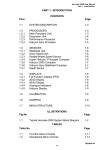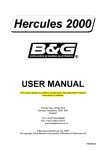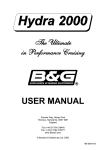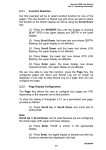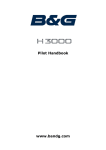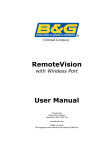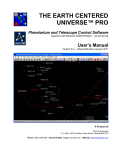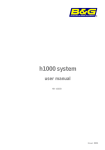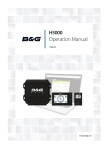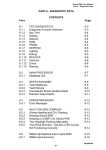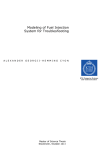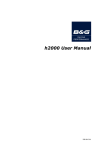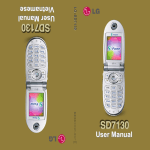Download Hydra-Pt 1-Intro_man - Chicago Marine Electronics
Transcript
Hydra 2000 User Manual Part 1 - Introduction PART 1 - INTRODUCTION CONTENTS Para Page 1.1 SYSTEM DESCRIPTION 1-3 1.2 1.2.1 1.2.2 1.2.3 PROCESSORS Main Processor Unit Expansion Unit Halcyon Gyro Processor 1-3 1-3 1-4 1-4 1.3 1.3.1 1.3.2 1.3.3 1.3.4 1.3.5 1.3.6 1.3.7 1.3.8 SENSORS Masthead Unit Paddle Wheel Sonic Speed Unit Depth Sensor Super Halcyon 3 Fluxgate Compass Halcyon 2000 Compass Halcyon Gyro Stabilised Compass Additional Sensors 1-4 1-4 1-5 1-5 1-5 1-5 1-5 1-5 1-6 1.4 1.4.1 1.4.2 1.4.3 1.4.4 1.4.5 1.4.6 DISPLAYS NMEA Full Function Display (FFD) Standard FFD 20/20 Display 40/40 Display Analogue Indicators Halcyon Display 1-6 1-6 1-7 1-7 1-7 1-7 1-7 1.5 CALIBRATION 1-8 1.6 DAMPING 1-8 1.7 MENU STRUCTURE 1-8 ILLUSTRATIONS Fig No 1.1 Page Typical Hydra 2000 System Block Diagram 1-2 TABLES Table No Page HB-0844-04 1-1 Hydra 2000 User Manual Part 1 - Introduction 1.1 1.2 Function Menu Choices Operational Menu Choices HB-0844-04 1-2 1-9 1-11 Hydra 2000 User Manual Part 1 - Introduction GPS Antenna Unit Mast Head Unit 20/20 20/20 Mast Halcyon Compass Display FFD Hal cyon 000 Deck GPS Plus FFD 000 Chart Table NMEA FFD 000 Hydra 2000 Main Processor EP Network Hull Additional Sensors Sea and Air Temperature, Heel, Trim, Barometric Pressure and Strain Sonic Speed Unit Halcyon 2000 Compass Boat Speed Depth Fig 1.1 - Typical Hydra 2000 System Block Diagram HB-0844-04 1-3 Hydra 2000 User Manual Part 1 - Introduction PART 1 - INTRODUCTION 1.1 SYSTEM DESCRIPTION The Hydra 2000 is a fully integrated instrumentation system that displays information obtained from various sensors on a choice of displays positioned throughout the yacht. Information is fed from the sensors to a Main Processor. From the information gathered by the sensors the Main Processor distributes information to the various displays via the Fastnet cable. This allows it to carry out a wide range of functions including dead reckoning, true wind speed and true wind direction, etc. These functions are controlled from a Full Function Display (FFD). A typical system is shown in Figure 1.1 - Typical Hydra 2000 System Block Diagram. 1.2 PROCESSORS 1.2.1 Main Processor Unit The Main Processor is the heart of the system and can be connected to sensors that measure the following: Boat Speed/Log Depth Sea Temperature Air Temperature Compass Heading Apparent Wind Speed Apparent Wind Angle Ship's Supply Voltage Heel Angle Trim Angle Mast Rotation Barometric Pressure Forestay Load From this information the Main Processor Unit is then able to calculate the following additional functions: Average Boat Speed HB-0844-04 1-4 Hydra 2000 User Manual Part 1 - Introduction Velocity Made Good (VMG) upwind/downwind Resettable Log Dead Reckoned Course and Distance Leeway Heading Corrected for Leeway (Course) True Wind Speed True Wind Angle True Wind Direction Heading on Next Tack or Gybe Pressure Trend In addition, the processor provides four outputs for analogue indicators. Any one of eight different types of analogue indicator can be used on any one of these outputs. It also contains the battery backed memory that stores all the calibration, damping and alarm settings whilst the power is OFF. These are adjustable from any FFD. 1.2.2 Expansion Unit The Expansion Unit allows a further four analogue indicators and a number of additional sensors to be added to the system. Further details are given in Part 5 - Options. 1.2.3 Halcyon Gyro Processor The Halcyon Gyro Processor Unit is an interface between the Halcyon Gyro Stabilised Compass and the B&G Fastnet Network. It also outputs NMEA heading information for use with other marine instruments and AD10 for use with Radar. The Halcyon Gyro Processor accepts NMEA data from your position fixer for magnetic variation information to allow display and output of True referenced heading. The Halcyon Gyro Processor can also be used as an interface to either output NMEA heading and AD10 from a B&G system compass, or to accept True heading NMEA information from a gyro compass to output and display on a B&G system, along with AD10 and NMEA outputs. Full details are given in Part 3 – Calibration. 1.3 SENSORS HB-0844-04 1-5 Hydra 2000 User Manual Part 1 - Introduction 1.3.1 Masthead Unit The Masthead Unit senses apparent wind speed and wind angle. The unit is light weight and sealed. 1.3.2 Paddle Wheel The Paddle Wheel Speed Sensor is designed primarily for cruising yachts and consists of a paddle wheel that protrudes through the hull via a housing. So that the paddle wheel may be cleaned at regular intervals the housing is provided with a flap valve that closes automatically when the unit is pulled back into the yacht. 1.3.3 Sonic Speed Unit The Sonic Speed Unit provides highly accurate and stable boat speed measurement. It does not rely on mechanical moving parts that require constant attention to protect them from weed, etc. The transducers are fitted virtually flush with the hull, creating almost zero drag, and can be painted, faired or anti-fouled. 1.3.4 Depth Sensor This can either be a removable through-hull unit, or moulded in-hull for reduced drag. The depth datum can be set to the waterline, the bottom of the keel or from the transducer. 1.3.5 Super Halcyon 3 Fluxgate Compass This fluxgate compass sensor is fully gimballed in a bath of oil, ensuring accurate readings at all normal angles of heel and pitch. The unit features automatic deviation correction, thus eliminating the need for expert compass adjustment. 1.3.6 Halcyon 2000 Compass The Halcyon 2000 Compass is a high performance electronic fluxgate compass for use on both sailing and power craft. It is intended to be connected to Hercules 2000, Hydra 2000 or HS 2000 instrument systems through the B&G Fastnet Network. HB-0844-04 1-6 Hydra 2000 User Manual Part 1 - Introduction The Halcyon 2000 Compass has the ability to ‘learn’ the magnetic effect of the vessel on the compass and automatically apply deviation correction. 1.3.7 Halcyon Gyro Stabilised Compass The Halcyon Gyro Stabilised Compass (HGSC) is a high performance, solid state compass that provides the best available heading information through the use of rate gyros to correct for the motion of your yacht. It also provides high accuracy Heel and Trim. It interfaces to Hercules, Hydra and HS 2000 instruments via the Halcyon Gyro Processor that transmits this information to the B&G Fastnet Network. The HGSC is an easily calibrated compass that ‘learns’ the magnetic effects of your vessel on the compass and automatically applies the deviation correction. 1.3.8 Additional Sensors Additional sensors provide either single inputs, or improve the accuracy of other functions on the system and they are discussed in Part 5 - Options. 1.4 DISPLAYS 1.4.1 NMEA Full Function Display (FFD) This is the standard system display and every Hydra 2000 must contain one NMEA FFD. The Standard FFDs and the other display types, described in this Section, are options with which the system can be expanded and made even more powerful. The FFD's name gives an indication to the fact that they are really much more than just a display. It is a terminal for the whole system, allowing you to control everything from the functions displayed on them (and at the 20/20’s) to the calibration of the system. HB-0844-04 1-7 Hydra 2000 User Manual Part 1 - Introduction The FFD simultaneously displays two functions. Any system function can be called up on any FFD and can be placed on the system, all with full control of the Hydra 2000. The NMEA FFD contains a NMEA interface which allows your Hydra 2000 System to be connected to devices such as position fixers, autopilots, chart plotters and radars, etc. from different manufacturers. For example your GPS Plus may be at the chart table, but you require its information to steer by on deck. Your Hydra displays can show that information if interfaced to your GPS Plus. The Hydra System can also provide information to your autopilot. NMEA is the National Marine Electronics Association, who have produced a number of standard specifications for the interconnection of marine electronic instruments. These standards specify the electrical signals and the format of the data to be transferred. Part 2 - Operating Information describes in detail the use of the FFD keyboard to control the Hydra 2000. Part 4 - Installation Information shows NMEA in/out specifications. 1.4.2 Standard FFD The Standard FFD is functionally identical and similar in appearance to the NMEA FFD. The only difference is that the Standard FFD is not fitted with a NMEA interface. 1.4.3 20/20 Display The Hydra 2000 20/20 is a lightweight, large digit, liquid crystal display - it can be configured from any FFD or a remote button to display any system function. The 20/20's operation is fully explained in Part 5 - Options. 1.4.4 40/40 Display HB-0844-04 1-8 Hydra 2000 User Manual Part 1 - Introduction The Hercules 2000 40/40 is a lightweight, large digit, liquid crystal display which can be configured from any FFD or a remote button to display any system function. The 40/40’s operation is described in Part 5 - Options. 1.4.5 Analogue Indicators There is a wide range of analogue indicators available. Refer to Part 5 - Options for full details. 1.4.6 Halcyon Display This is a dedicated compass display that shows heading in digital form and has a bar graph display that can be used as a steering indicator. Refer to Part 5 - Options for further details. 1.5 CALIBRATION Before using the Hydra 2000 for navigational purposes it is important that the system is correctly calibrated for your installation. The calibration process has been simplified as much as possible, so that all you need is accurate information. This is fully explained in Part 3 - Calibration. 1.6 DAMPING A useful feature is that the damping on most functions is adjustable. This allows you to slow down the response of the function if it is too jumpy in rough weather, and similarly to speed it up if it is too slow in flat water. The damping works by averaging the numbers over a user adjustable time period. The more you increase this time period the smoother the data readings will get, but the longer it will take to see the effect of any change. Similarly the lower it is the bigger the jumps you will get in the numbers but the response to any change will be quicker HB-0844-04 1-9 Hydra 2000 User Manual Part 1 - Introduction remember, high damping for rough weather, low damping for calm weather. Damping should not be confused with the update rate which is the number of times each second that the function value is sent to the display. It is fixed for all the functions. 1.7 MENU STRUCTURE The central concept to the operation of the system is the structure of the Function Menus accessed through the FFD, and once this is grasped, operation very quickly becomes familiar. The idea of structured layers of menus is one seen everywhere in modern software, and regular computer users will be familiar with this concept. The principle is that at any one level there is a set of choices which you can scroll through (select) until you find the one you want. Having found the correct menu entry, it is then selected - the FFD then displays the first choice in the next level of menu down. Here you once again scroll through the available options until you find and select your choice. The function options available through each Menu Choice are listed in Table 1.1 - Function Menus. Operational Menu choices together with the Function Menu applicable are listed in Table 1.2 Operational Menu Choices. Note The Functions available to the user are dependent on the range of sensors fitted to the system. Details of the sensors required for each function are fully explained in Part 3 - Operating Information. Table 1.1 - Function Menu Choices FUNCTION MENU CHOICE Boat Speed HB-0844-04 1-10 FUNCTION TEXT BOAT SPD Hydra 2000 User Manual Part 1 - Introduction Speed Average Speed AVG SPD Velocity Made Good VMG Log Stored Log STD LOG Trip Log TRIP LOG Depth - Meters DEPTH M Depth Depth - Feet DEPTH FT Depth - Fathoms DEPTH FM Heading HEADING Off Course OFF CRSE Dead Reckoning Course D/R CRSE Navigate Dead Reckoning Distance D/R DIST Course COURSE Leeway LEEWAY Tidal Set TIDE SET Tidal Drift TIDE RTE Apparent Wind Speed APP W/S True Wind Speed TRUE W/S Apparent Wind Angle APP W/A Wind True Wind Angle TRUE W/A True Wind Direction TRUE DIR Head/Lift Trend LIFT/HDR Apparent Wind Speed m/s APP W/S MS True Wind Speed m/s TRUE W/S MS Table 1.1 - Function Menu Choices (Contd.) FUNCTION MENU CHOICE Perform Opposite Tack Layline Heel Angle Fore/Aft Trim Mast Angle Wind Angle to the Mast Bearing W/point to W/point Mag. Bearing W/point to W/point True Bearing to W/point Rhumb Mag. Bearing to W/point Rhumb True Brg to W/point Great Circle Mag. Brg to W/point Great Circle True Distance to Waypoint Rhumb Distance to Waypoint Great Circle Waypoint FUNCTION TEXT OPP TACK LAYLINE HEEL TRIM MAST ANG W/A MAST BRG W-W M BRG W-W T BTW RMB M BTW RMB T BTW GC M BTW GC T DTW RMB DTW GC HB-0844-04 1-11 Hydra 2000 User Manual Part 1 - Introduction Motor Temperature Timer Miscellaneou s External Course over Ground Mag. CRSE O/G M Course over Ground True CRSE O/G T SPD over Ground SPD O/G VMG to Waypoint VMG WPT Estimated Time of Arrival to WPT ETA WPT Cross Track Error CROSS TR Battery Voltage VOLTS Sea Temperature °C SEA TEMP °C Sea Temperature °F SEA TEMP °F Air temperature °C AIR TEMP °C Air Temperature °F AIR TEMP °F Timer TIMER Linear 1 LINEAR 1 Linear 2 LINEAR 2 Linear 3 LINEAR 3 Linear 4 LINEAR 4 Barometric Pressure BAROMETER Barometric Pressure Trend PR TREND Rudder Angle RUDDER Remote 0 to 9 REMOTE 0 TO 9 HB-0844-04 1-12 Hydra 2000 User Manual Part 1 - Introduction Table 1.2 - Operational Menu Choices OPERATION Log Control AVAILABLE FUNCTION(S) Trip Log D/R Course D/R Distance Timer Control Timer PR Trend Control PR Trend Alarm Control Sector Alarm Control Damping Control BOAT SPD APP W/S DEPTH VOLTS SEA TEMP AIR TEMP HEADING APP W/A BOAT SPD APP W/A APP W/S HEADING TRUE W/A TRUE W/S HEEL TRIM TIDE RUDDER ANGLE OPERATIONAL CHOICE RESET RUN FREEZE FREEZE START 0 START 5 START 10 START 15 PERIOD RESET ALL OFF HI ALARM HI ON HI OFF LO ALARM LO ON LO OFF ALL OFF SECTOR SECT ON SECT OFF DAMPING VALUE HB-0844-04 1-13 Hydra 2000 User Manual Part 1 - Introduction Table 1.2 - Operational Menu Choice (Contd.) OPERATION AVAILABLE FUNCTION(S) Calibrate Log (AUTO CAL) BOAT SPD STD LOG Calibrate Log (MANL CAL) BOAT SPD STD LOG Calibrate Log (Ref Cal) Calibrate Temp Boat SPD Calibrate Datum Calibrate App W/A Calibrate App W/S Calibrate Wind All Other Calibrate Functions OPERATIONAL CHOICE SINGLE PORT CAL STBD CAL CAL DIST STRT RUN STOP RUN END CAL SINGLE PORT CAL STDB CAL Reference CAL Sea Temp °C Sea Temp °F DEPTH DATUM (+/-) APP W/A MHU ANGL APP W/S MHU CAL MHU OFFS CORRECTN TRUE W/A TRUE W/S Selected Function HB-0844-04 1-14 OFFSET C CAL VALUE 1 CAL VALUE 2 CAL VALUE 3 CAL VALUE 4














